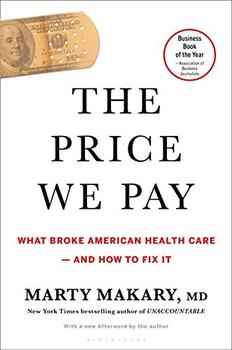Summary | Excerpt | Reviews | Beyond the Book | Readalikes | Genres & Themes | Author Bio

What Broke American Health Care--and How to Fix It
by Marty MakaryExcerpt
The Price We Pay
A few years ago, South Korea found itself in the middle of a thyroid cancer epidemic. Starting around 2000, Korean doctors were finding an alarming number of cancerous tumors on the thyroid, a gland in the neck that makes hormones to regulate the body. The rate of thyroid cancer rose at an alarming rate, with yearly increases. Between 1992 and 2011, the Korean thyroid cancer rate increased by a factor of 15, making it the worst in the world for the disease. Thyroid cancer is easy to treat if caught early. And the Korean medical industry responded to the crisis with full force. Hospitals expanded thyroid clinics, hired surgeons, and invested in surgical robots to perform operations to remove tumors. The rate of thyroid surgery skyrocketed more than tenfold. About 4,000 Korean patients underwent surgery for thyroid cancer in 2001. By 2012, about 44,000 Koreans had undergone the same operation.
Thyroid cancer cases consumed valuable resources, and the economic burden of thyroid cancer in South Korea increased sevenfold, from $257 million in 2000 to $1.7 billion in 2010. Korean surgeons got very good at the operation. I remember watching teaching videos from Korea showing elegant and creative ways to remove the thyroid gland, or parts of it, through an incision in the armpit. We often joked that the reason Korean surgeons were the slickest in world at minimally invasive thyroid surgery was that there were no obese people in Korea.
When you look back a few years later, you would think everyone would celebrate the Korean medical community's response to the crisis. But instead, medical journals recount it as a tragic cautionary tale. About 90 percent of the cancer cases identified during the "epidemic" were actually overdiagnoses. Research published in the New England Journal of Medicine found that a third of all adults normally harbor small papillary thyroid cancers, and the vast majority won't ever produce symptoms. The tumors are so common, and often so harmless, that most would be better considered a "variant" of normal rather than a deadly disease.
What caused the Korean epidemic wasn't an increase in cases of dangerous thyroid cancer. The rate grew so fast because the medical community started widespread screening of patients who had nothing wrong with them. The screening identified a lot of cases that probably wouldn't have caused any problems. And identifying those cases led to treatment.
Looking back, we can see several telltale signs that the Korean cancer epidemic was not real. During the spike in thyroid cancer cases there was no corresponding increase in mortality. In 2011, more than 40,000 Koreans were diagnosed with thyroid cancer, but fewer than 400 died—a similar figure to previous years. In addition, the median tumor size of the tumors that were surgically removed got much smaller over time: from 20 millimeters in 1999 to 9 millimeters in 2008. Tumors of 9 millimeters are too small for patients or doctors to notice at high rates, a study in the BMJ said. "It is not possible that so many tumors of less than 20 mm were detected clinically."
A group of Korean doctors first raised the alarm that overdiagnosis may be to blame for the apparent outbreak of thyroid cancer. In 2014, eight Korean doctors formed the Physician Coalition for Prevention of Overdiagnosis of Thyroid Cancer. The coalition wrote an open letter to the public that flagged screening with ultrasonography as the possible culprit for the spike in diagnoses. That led to media coverage, and in the next year, thyroid cancer operations dropped by 35 percent in South Korea.
Korea isn't the only country that's had a thyroid cancer "epidemic." It's estimated that 50 to 90 percent of thyroid cancers in women in high-income countries could be overdiagnoses, according to a 2016 report by the International Agency for Research on Cancer in collaboration with the Aviano National Cancer Institute in Italy. Korea was the most extreme example. An estimated 70 to 80 percent of women in Australia, France, Italy, and the United States with the diagnosis were misdiagnosed, according to the report. "More than half a million people are estimated to have been overdiagnosed with thyroid cancer in the 12 countries studied," the IARC director said in a press release. He called the overdiagnosis problem a "serious public health concern."
* * *
From The Price We Pay by Marty Makary. Used with the permission of the publisher, Bloomsbury. Copyright © 2019 by Marty Makary.






Your guide toexceptional books
BookBrowse seeks out and recommends the best in contemporary fiction and nonfiction—books that not only engage and entertain but also deepen our understanding of ourselves and the world around us.